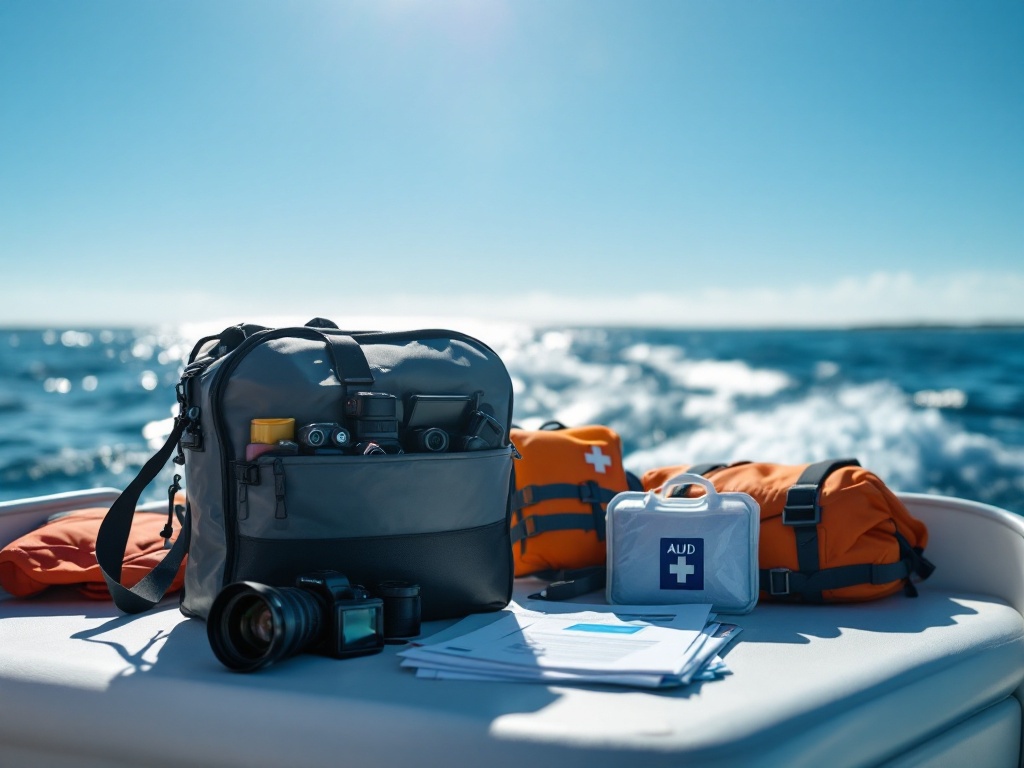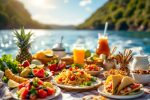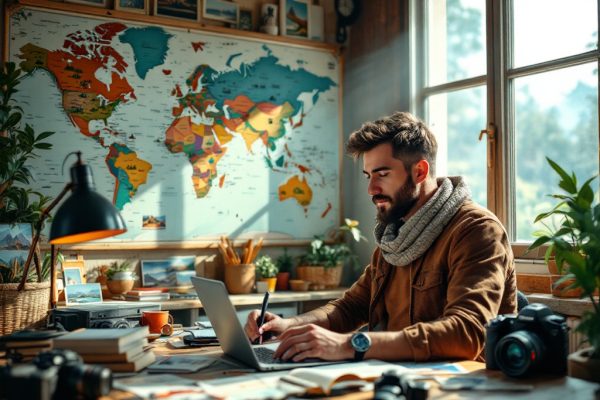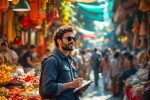What to Bring on a Boat Trip as a Journalist
Embarking on a boat trip as a journalist? Ensure a successful and safe voyage by preparing adequately. This guide details essential gear, from waterproof bags for electronics and vital documents to safety equipment like life jackets and first-aid kits. Learn how to protect your cameras and recording devices while navigating unpredictable weather. Discover packing tips and organizational strategies for easy access to your tools. Dive in and prepare for a smooth and productive journalistic adventure on the water.
Important information

- Safeguard your equipment: Use waterproof bags and cases to protect electronics and documents from water damage.
- Prioritize safety: Pack a life jacket, whistle, and a well-stocked first-aid kit including seasickness medication.
- Plan and research: Prepare a detailed packing list and research your destination to enhance your reporting.
- Pack essential journalist gear: Bring cameras, recording devices, extra batteries, chargers, and SD cards.
- Dress appropriately: Wear light, quick-drying layers, a waterproof jacket, windbreaker, non-slip shoes, and sun protection.
Preparing for a Boat Trip as a Journalist
Essential Documentation Tools
Carry a logbook or travel journal to meticulously record your experiences, observations, and insights throughout the voyage.
Safeguarding Your Equipment
Protect your valuable electronics, such as cameras, laptops, and notepads, from water damage by storing them in waterproof bags.
Prioritizing Safety Measures
Pack essential safety items, including a life jacket, a whistle, and a first-aid kit. Familiarize yourself with the boat’s safety procedures before departure.
Provisioning for Sustenance
Pack non-perishable, easy-to-consume food and drinks to maintain energy levels throughout your journey. Consider seasickness medication if needed.
Pre-Trip Research and Planning
Thoroughly research your destination’s history, culture, and environment to enrich your reporting. Create a comprehensive checklist tailored to your trip’s length and reporting assignments.
Comprehensive Documentation
Capture high-quality photos and videos, and maintain detailed notes to support your storytelling across different media platforms.
Maintaining Organization
Use waterproof bags, checklists, and a compact backpack to keep your equipment and belongings organized and easily accessible during the trip.
Boat Safety and Communication
Understand the boat’s safety protocols and inform someone of your itinerary before departure for added peace of mind.
Understanding the Unique Needs of Travel Journalism
Travel journalism blends insightful reporting with captivating narratives, documenting experiences while capturing the essence of a place. It informs audiences about diverse destinations. These journalists utilize specialized equipment, including cameras, recording devices, and essential communication tools. Often working remotely, they rely on portable power and efficient data storage. Adaptability is key, as assignments can vary dramatically, from luxurious cruises to challenging expeditions. Effective travel journalism strikes a balance between creating engaging content and demonstrating respect for local cultures and customs. Responsible travel practices are vital. Moreover, travel journalists must be prepared for unexpected situations, like interviewing locals or navigating unfamiliar terrain. Ultimately, this field offers a unique fusion of adventure and knowledge.
Essential Tools for Travel Journalists
- Cameras for capturing high-quality photos and videos.
- Recording devices for interviews and ambient sounds.
- Communication tools for staying connected.
- Portable power solutions for remote work.
- Efficient data storage for managing large files.
Key Skills for Travel Journalists
- Adaptability to diverse assignments and environments.
- Respect for local cultures and customs.
- Preparedness for unexpected situations.
- Strong communication and storytelling abilities.
- Resourcefulness in unfamiliar terrain.
Importance of Packing in Advance
Packing in advance is crucial for journalists. It allows for a thorough equipment check, ensuring cameras, recorders, and laptops are functional. Don’t forget chargers and batteries. This preparation minimizes the risk of forgetting essential gear.
Essential Clothing and Weather Gear
Start with lightweight, quick-drying base layers made of nylon or polyester to wick away moisture and keep you dry.
Layering allows you to adjust to changing weather conditions.
Pack a waterproof jacket for rain protection and a windbreaker for added warmth.
Choose proper footwear that is crucial for navigating a wet deck.
Non-slip, non-marking boat shoes or deck shoes with rubber soles provide excellent traction and protect the boat’s finish.
Weather-Appropriate Clothing
Dress in light, quick-drying layers for optimal temperature regulation while sailing. This adaptability is crucial for fluctuating weather conditions.
A waterproof jacket offers essential protection from splashes and rain.
On deck, comfortable non-slip shoes are vital for safety.
Complete your sailing attire with a wide-brimmed hat and sunglasses for crucial sun protection.
Waterproof Jackets and Windbreakers
stay dry with a waterproof jacket.
stay warm with a windbreaker.
For optimal comfort on your boat trip, pack both to be prepared for any weather.
Non-Slip and Non-Marking Shoes
Boat shoes are essential for both your safety and the well-being of your vessel. Their non-slip design provides crucial traction on wet decks, preventing potentially dangerous falls. Non-marking soles, often made from specialized rubber compounds, protect the boat’s finish from unsightly scuffs and more serious damage. Deck shoes, also known as sailing shoes, are specifically engineered for the marine environment, featuring siped soles that dramatically enhance grip on wet surfaces. This specialized footwear offers the combined benefits of superior traction and surface protection, making them a wise investment for any boater.
Safety and Navigation Essentials
Essential boating safety equipment includes the following:
- Life jackets or PFDs to keep you afloat during emergencies.
- Navigation tools, like charts, GPS devices, and compasses, are vital for staying on course and avoiding hazards.
- A waterproof flashlight is crucial for visibility in low light and emergencies.
- A two-way radio enables you to contact help if needed.
- A well-stocked first-aid kit with seasickness medication and other medical supplies can address minor injuries and queasiness.
With these items on board, you’ll be well-prepared for a safe and enjoyable boating trip.
Lifejacket and Personal Floatation Device (PFD)
Prioritize safety with life jackets and personal flotation devices (PFDs) for all passengers. These provide essential buoyancy and greatly increase the chances of survival in emergencies.
Pack a comprehensive first-aid kit. Include essential supplies like bandages, antiseptic wipes, pain relievers, motion sickness medication, and any personal medications needed.
Ensure effective communication by including a whistle, a flashlight with spare batteries, and a waterproofed phone or marine radio. These tools are crucial for signaling and contacting help in case of emergencies.
Protect your valuables and essential belongings by storing them in a waterproof dry bag. This will keep them safe and dry even in wet conditions.
Shield yourself from the sun’s harmful rays. Carry sunscreen with a high SPF, wear a wide-brimmed hat, and use sunglasses to protect your skin and eyes.
Navigation Tools and Nautical Charts
Navigation relies on essential tools like GPS devices and compasses for charting courses and pinpointing locations. Nautical charts are equally vital, detailing water depths, hazards, and navigational aids for safe passage. These tools are especially crucial for journalists navigating independently.
Flashlights and Waterproof Flashlights
Waterproof flashlights are essential tools for navigating dark environments and signaling for help. They offer reliable performance even when submerged, making them crucial for emergencies, particularly in maritime situations. This waterproof feature guarantees visibility in rain or wet conditions, establishing these flashlights as vital safety devices.
Two-Way Radio
Two-way radios are crucial for boating safety, providing a vital link with your crew and other vessels, especially where cell service is unreliable. This enhances coordination and safety throughout your trip, making reliable communication a critical factor.
First-Aid Kit and Seasickness Medication
Pack a comprehensive first-aid kit for a comfortable trip. Include essential items like bandages, antiseptic wipes, and pain relievers. Don’t forget motion sickness medication, personal prescriptions, and seasickness remedies such as acupressure wristbands or ginger candies. Also, pack antihistamines for allergies and insect repellent.
Journalistic Tools and Technology
Planning a boat trip? Don’t forget to pack essential photography and recording equipment to capture stunning visuals and crisp audio.
For capturing stunning photos and videos:
- High-quality camera with versatile lenses, for capturing diverse shots.
- SD cards and a card reader, for secure storage and transfer.
- Chargers and portable power banks, to keep your devices powered up.
For capturing high-quality audio and aerial footage:
- A good quality microphone, for crisp and clear audio recording.
- A drone with a stabilizer, for smooth, breathtaking aerial footage.
Photography and Recording Equipment
Desire breathtaking photos? A digital camera is key.
Need captivating videos? Opt for an action camera.
For truly professional footage, a stabilizer is a must-have. Together, these tools empower you to generate top-tier content.
Chargers and Portable Batteries
Remember to pack chargers for essential electronics like cameras, laptops, and phones. A portable power bank is highly recommended, especially for longer trips or situations where onboard power is limited, ensuring your devices remain charged and ready to capture every memory.
SD Cards and Card Readers
Safeguard your precious photos and videos by packing several SD cards. A card reader is essential for transferring files to your computer or other devices, enabling both backup and editing. Multiple SD cards are highly recommended to protect against data loss.
Drone and Stabilizer for Aerial Shots
Drones capture breathtaking aerial perspectives. A gimbal stabilizes the camera, eliminating shake and vibration for smooth, professional-quality footage.
Health and Personal Care
Pack a high-SPF sunscreen for crucial sun protection. For comfort and cleanliness, bring personal hygiene items such as a toothbrush, toothpaste, soap, and shampoo. A small, waterproof toiletry bag will help keep these essentials organized.
Sun Protection and Sunscreen
Shield your skin with a broad-spectrum, water-resistant sunscreen of SPF 30 or higher. Reapply every two hours, especially after swimming or sweating. For added protection, wear a hat and sunglasses.
Personal Toiletries and Hygiene
When packing, remember your essential toiletries.
- toothbrush,
- toothpaste,
- soap,
- shampoo,
- deodorant,
- any medications.
Travel-sized versions are space-saving and lightweight. A small, waterproof toiletry bag keeps everything organized and dry. Hand sanitizer and wet wipes are great for quick cleanups, especially when water isn’t readily available. A quick-drying towel is also a smart addition.
Packing Tips for Journalists on a Boat Trip
Safeguard your electronics, notebooks, and valuables from water damage by using waterproof bags. This also helps keep your gear organized.
Utilize separate bags or dry sacks for different categories of items. For example, electronics, clothing, and first-aid supplies should be packed individually for quick access and to safeguard against loss or damage.
Prepare a packing list to avoid forgetting essential items. Such items may include cameras, chargers, or safety equipment.
Remember that while waterproof bags protect against splashes and rain, submersion requires specialized protection. Consider using individual waterproof cases for added security, especially for sensitive electronics.
Using Waterproof Bags
Use waterproof bags to protect your electronics from splashes and unexpected showers.
For added safety, use individual waterproof cases and silica gel packets to absorb moisture.
Store devices in a dry compartment when not in use for maximum protection.
Organizing Travel Gear and Packing List
Pack your electronics, notebooks, and personal belongings in waterproof bags to protect them from the elements. Use a comprehensive packing list to avoid leaving behind any essentials. This list should include crucial documents, appropriate gear, and clothing suitable for various weather conditions. Don’t forget a first-aid kit for minor emergencies, a waterproof camera to capture your adventures, and a portable charger to keep your devices powered up. A compact backpack is also essential for keeping tools and equipment readily accessible.














